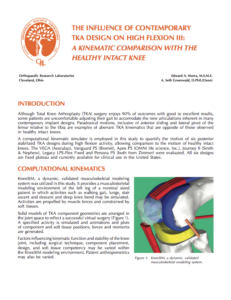 Although Total Knee Arthroplasty (TKA) surgery enjoys 90% of outcomes with good to excellent results, some patients are uncomfortable adjusting their gait to accommodate the new articulations inherent in many contemporary implant designs. Paradoxical motions, inclusive of anterior sliding and lateral pivot of the femur relative to the tibia are examples of aberrant TKA kinematics that are opposite of those observed in healthy intact knees. A computational kinematic simulator is employed in this study to quantify the motion of six posterior stabilized TKA designs during high flexion activity, allowing comparison to the motion of healthy intact knees.
Although Total Knee Arthroplasty (TKA) surgery enjoys 90% of outcomes with good to excellent results, some patients are uncomfortable adjusting their gait to accommodate the new articulations inherent in many contemporary implant designs. Paradoxical motions, inclusive of anterior sliding and lateral pivot of the femur relative to the tibia are examples of aberrant TKA kinematics that are opposite of those observed in healthy intact knees. A computational kinematic simulator is employed in this study to quantify the motion of six posterior stabilized TKA designs during high flexion activity, allowing comparison to the motion of healthy intact knees.
The Influence of Contemporary Knee Design on High Flexion III: A Kinematic Comparison with the Healthy Intact Knee
Mar 8, 2014 | Knee

